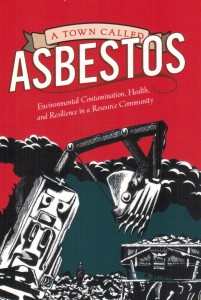Buried in a film vault at the federal archives is a Canadian Paramount newsreel circa 1952 shown in movie theatres nationwide. Cue marching music then title board: “World’s Largest Asbestos Mill!” The camera pans across an industrial complex six city blocks long as the announcer shouts, “The new plant will process more than a third of the free world’s supply of the magic mineral!”
It was a ribbon cutting at Johns Manville Co.’s Jeffery Mine in Asbestos, Que. The premier and archbishop showed up. Coroners had known since 1906 asbestos dust was fatal. The fact was not mentioned.
UBC Press has published the true story never shown in theatres. A Town Called Asbestos documents a lethal product produced and sold with the blessing of regulators and lawmakers alike. “The people of Asbestos should not have had to choose between their jobs and their health but that is just what many had to do,” writes author Jessica van Horssen.
Asbestos rock contains fibres akin to raw cotton and can be woven like cloth. The fibres are resistant to rust and flame. Asbestos fireproofed buildings from the House of Commons to waterfront warehouses. It was used in hospital ceiling tiles, aircraft oxygen bottles, electrical wiring and army uniforms.
Milling produces extraordinary amounts of dust. Even the Paramount newsreel shows clouds of dust billowing from a production line. When Johns Manville commissioned its own industrial film in 1975 the crew complained of working conditions.
“The bagging operation on the main floor was shocking,” a filmmaker wrote. “There were accumulations of dust everywhere. It took more than an hour to clean up one bagging unit visible of dust before filming. At another bag unit I noticed an ankle-high accumulation of fibre which was being shoveled onto an open cart for disposal by a worker who was not wearing a respirator.”
The dust hardens the lungs and fatally suffocates its victims. It is a slow, awful death. “The townspeople had no idea that Johns Manville was using the community as a giant research laboratory with the workers and their families acting as test mice,” van Horssen writes.
Regulators did know. The British Medical Journal diagnosed asbestos dust as a workplace peril as early as 1927. Le Devoir published the first press account of the dangers in 1949. The company’s own cancer studies in 1971 confirmed a link between the incidence of lung disease and the proximity of homes to its kilometre-long open pit Jeffrey Mine.
Yet Health Canada did not cite asbestos as toxic till 1975 – the year Johns Manville finally mandated respirators at the mill – and Québec and federal regulators continued to promote its overseas sale long after litigation drove Johns Manville into bankruptcy in 1983. Nobody went to jail. “There is an intimacy between life and labour in resource communities,” says van Horssen.
A Town Called Asbestos is a crisp narrative that documents something close to manslaughter. If economic necessity saw mill employees literally work themselves to death, the recklessness of insurers and regulators remains inexplicable.
Van Horssen writes: “As I stood on the observation platform overlooking the Jeffrey Mine on one of my first research trips to Asbestos, I was distracted from the pit by the sounds of children playing below me. On each side of the platform are piles of stone taken from the Jeffrey Mine, with asbestos still embedded in the rock.”
“Two young boys had placed their bicycles against the chain-link fence that separates the mine from the town and were playing in these piles of asbestos, throwing the rocks up into the sky and taking much delight when they came back down and exploded in clouds of dust. When I drove away from Asbestos that day, foolishly holding my breath and trying not to rub my suddenly itchy eyes, the children remained, laughing and holding pieces of the mineral up to the sun, watching it sparkle and shine.”
By Holly Doan
A Town Called Asbestos: Environmental Contamination, Health & Resilience in a Resource Community, by Jessica van Horssen; University of British Columbia Press; 256 pages; ISBN 9780-7748-28420; $32.95






